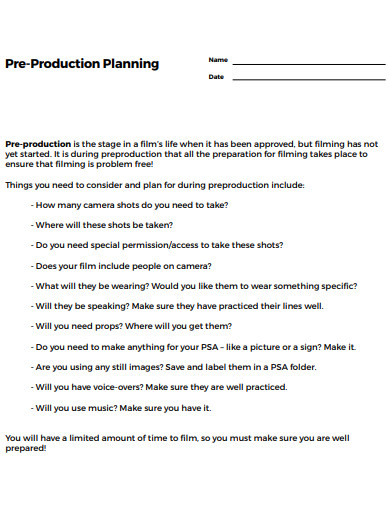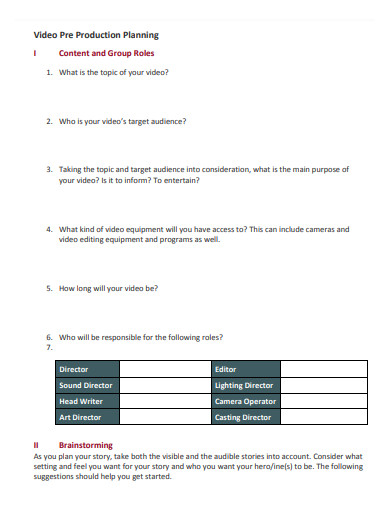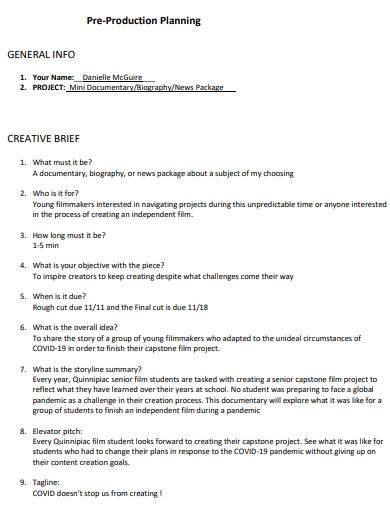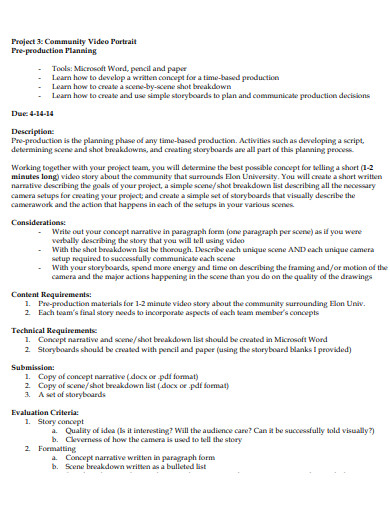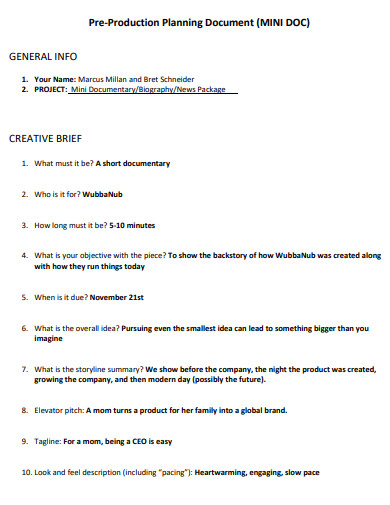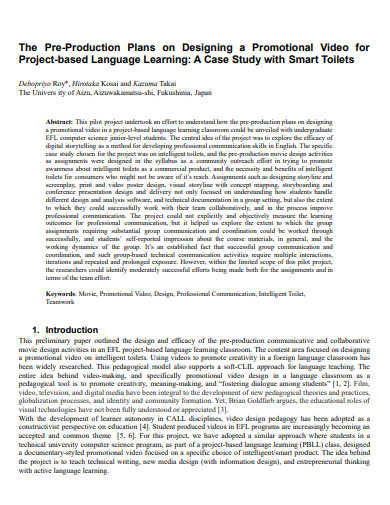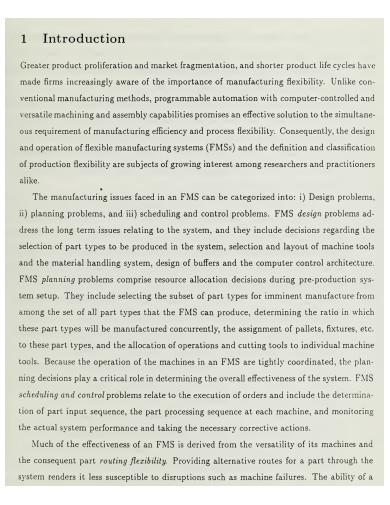Pre-production is the phase of a film, television show, or advertisement that occurs before filming begins. Production (during which visual content will be filmed) and post-production are the next steps (where the filmed visual content will be edited into a coherent whole). Making mistakes throughout this stage of the production process can be disastrous for a project. When done correctly, it can assist in laying the groundwork for a successful production. You’ll finalize your script, hire your actors and crew, scout locations, source equipment, and create a shooting schedule during pre-production. As a result, this crucial planning stage must be well-managed.
Pre-production is the stage in which you get your project ready to shoot. Production is the stage in which all of your sequences are shot. Postproduction is the process of assembling all of the sequences shot into the final film. As you might expect, the success of the second and third stages is highly dependent on the work you complete in the first.
10+ Pre-Production Plan Samples
1. Pre-Production Plan
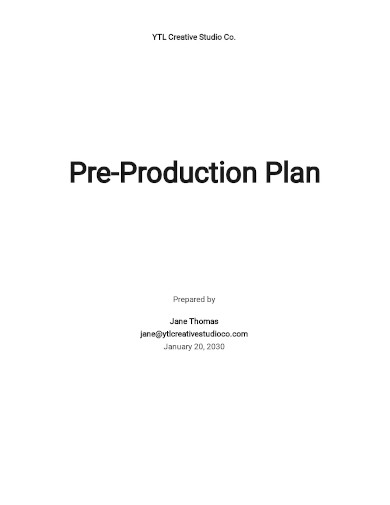
2. Sample Pre-Production Plan
3. Pre and Post Production Plan
4. Video Pre-Production Plan
5. Sample Pre-Production Plan
6. Pre-Production Plan Example
7. Film Pre-Production Plan
8. Sample Video Pre-Production Plan
9. Basic Pre-Production Plan
10. Formal Pre-Production Plan
11. Printable Pre-Production Plan
Elements of Pre-Production
Preproduction stages differ based on the type of project you’re filming (for instance, a 10-minute short film will have a significantly shorter and less involved preproduction period than a 90-minute movie). The preproduction process for most films, however, follows a similar pattern:
- Script breakdown – You’ll need to finalize your shooting script once a project has been greenlit. The first AD will go through the screenplay and develop a breakdown of all your times of day, locations, characters, stunts, extras, special effects, props, vehicles, animals, sound effects, music cues, and costumes—everything that is logistically significant. You’ll have fewer surprises during shooting and postproduction if you’re well-prepared.
- Budget – After you’ve determined what logistical components you’ll need to prepare for, you’ll need to determine how much it will cost. Whether you have a small or large budget, now is the moment to figure out how to make the film you want with the resources you have. To choose which funds to allocate were, research the costs of everything you’ll need.
- Schedule – Your production schedule (also known as a shooting schedule) will help you figure out when and where you’ll shoot each scene, as well as how many you’ll shoot per day. Time is a crucial resource, especially when dealing with variables such as sunshine and weather.
- Crew – Assemble your team and important department heads. A director, a first assistant director, a production manager, a cinematographer (sometimes known as a director of photography), a casting director, a production designer, and a costume designer are all people you’ll need to recruit. As preproduction progresses, these departments will grow, completing your crew.
- Planning – Each department collaborates with the line producer to deconstruct what they require to carry out the director’s vision. Location scouting and obtaining permits, as well as preparing a shot list and storyboard and determining props and equipment, are all part of the planning stage. Once those requirements are defined, the line producer (or production manager) will review and amend the budget to ensure that everything falls within the set constraints. To stay within your budget, you may need to remove some settings or objects, or even rework scenes.
- Talent – According to your script breakdown and director’s notes, the casting director auditions talent for all roles.
- Rehearsal – You’ll probably want to practice with the cast at the conclusion of the preproduction period and before your film shoot begins, sorting out the emotional and physical logistics of each scene. Meanwhile, your department heads will be working with the production coordinator to ensure that all of the pieces are in place for the final assembly. When everything is in order, it’s time to send out call sheets to the whole cast and crew, which detail the plan for each shoot day as the production phase gets underway.
FAQs
Why is preproduction important in filmmaking?
Before you start rolling the cameras, you can organize everything you need during the pre-production phase of filmmaking. Preproduction is the process of determining what you’ll need to make your film, how much it’ll cost, and who you’ll be able to recruit to assist you. When it comes to filmmaking, effective preproduction can help you save time and money (the two most scarce resources). You’re less likely to waste resources (or run out of money) if you have a budget in place, which can derail an entire project. Detailing the timeline is also important for a seamless production process since it gives the team a clear picture of how much time they need allot for an efficient shot.
Who are the crews in a pre-production?
It includes the line producer, unit production manager, first AD, director, and department heads.
You’ve gotten funding, finished your script, hired your crew, budgeted for everything, and planned out your production and shooting dates. You are now ready to advance your project from preproduction to production. It may have felt like trying to keep a lot of plates spinning at the same time at times, but all of the hard effort put in up to this point will pay off handsomely in the future. A well-managed preproduction period will prepare you for production in the best possible way. It takes a lot of effort just to get on set, but understanding all of the numerous factors involved makes doing everything right much easier.
Related Posts
Argumentative Writing Samples & Templates
Contract Cancellation Letter Samples & Templates
Sample Material Lists
Sample Excuse Letter for School
Feature Writing Samples
FREE 10+ Security Guard Contract Samples in PDF | MS Word
FREE 10+ Option to Purchase Agreement Samples in MS Word | Apple Pages | PDF
FREE 26+ Curriculum Form Samples in MS Word | PDF
FREE 20+ Cleaning Service Proposal Samples in PDF | MS Word
FREE 29+ Sample Loan Application Form Templates in MS Word | PDF
FREE 10+ Event Venue Contract Samples in PDF | MS Word | Pages | Google Docs
FREE 10+ SBAR Samples in PDF | DOC
FREE 12+ Music Band Contract Templates in PDF | MS Word
FREE 10+ HVAC Maintenance Contract Samples in PDF | MS Word
FREE 10+ Social Media Marketing Contract Samples in MS Word | PDF

